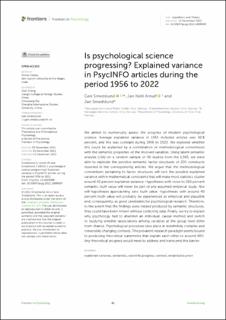Is psychological science progressing? Explained variance in PsycINFO articles during the period 1956 to 2022
Others
Published version
Date
2022Metadata
Show full item recordCollections
- Scientific articles [2181]
Original version
10.3389/fpsyg.2022.1089089Abstract
We aimed to numerically assess the progress of modern psychological
science. Average explained variance in 1565 included articles was 42.8
percent, and this was constant during 1956 to 2022. We explored whether
this could be explained by a combination of methodological conventions
with the semantic properties of the involved variables. Using latent semantic
analysis (LSA) on a random sample of 50 studies from the 1,565, we were
able to replicate the possible semantic factor structures of 205 constructs
reported in the corresponding articles. We argue that the methodological
conventions pertaining to factor structures will lock the possible explained
variance within mathematical constraints that will make most statistics cluster
around 40 percent explained variance. Hypotheses with close to 100 percent
semantic truth value will never be part of any assumed empirical study. Nor
will hypotheses approaching zero truth value. Hypotheses with around 40
percent truth value will probably be experienced as empirical and plausible
and, consequently, as good candidates for psychological research. Therefore,
to the extent that the findings were indeed produced by semantic structures,
they could have been known without collecting data. Finally, we try to explain
why psychology had to abandon an individual, causal method and switch
to studying whether associations among variables at the group level differ
from chance. Psychological processes take place in indefinitely complex and
irreversibly changing contexts. The prevalent research paradigm seems bound
to producing theoretical statements that explain each other to around 40%.
Any theoretical progress would need to address and transcend this barrier.

